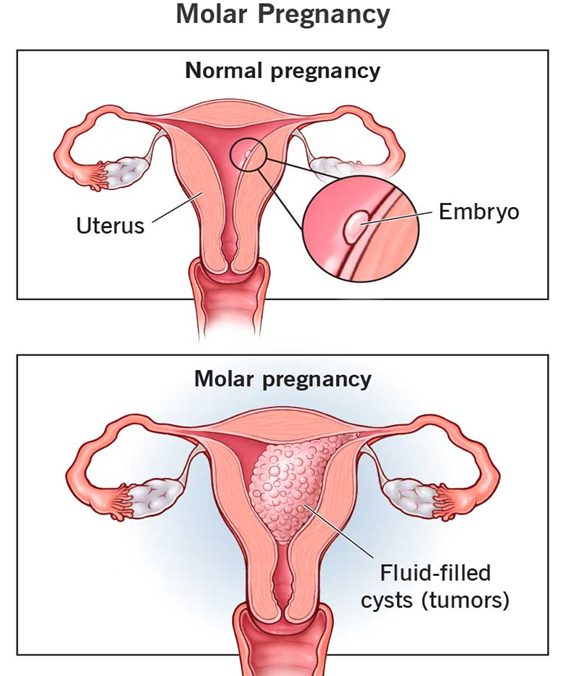A nurse in a prenatal clinic is caring for a client who is suspected of having a hydatidiform mole. Which of the following findings should the nurse expect to observe in this client?
Rapid decline in human chorionic gonadotropin (hCG) levels
Irregular fetal heart rate
Excessive uterine enlargement
Profuse, clear vaginal discharge
The Correct Answer is C
Choice A Reason:
A rapid decline in human chorionic gonadotropin (hCG) levels is not typically associated with a hydatidiform mole. In fact, hCG levels are usually elevated in cases of hydatidiform mole due to the abnormal growth of trophoblastic tissue. Elevated hCG levels can lead to symptoms such as severe nausea and vomiting, which are more indicative of this condition.
Choice B Reason:
An irregular fetal heart rate is not a common finding in hydatidiform mole cases. In a complete molar pregnancy, there is no viable fetus, and therefore, no fetal heart rate can be detected. In partial molar pregnancies, there may be some fetal tissue, but it is typically not viable and does not develop a regular heart rate.
Choice C Reason:
Excessive uterine enlargement is a hallmark sign of a hydatidiform mole. This condition causes the uterus to grow more rapidly than it would in a normal pregnancy due to the abnormal proliferation of trophoblastic tissue. This rapid growth can lead to a uterus that is significantly larger than expected for the gestational age.

Choice D Reason:
Profuse, clear vaginal discharge is not specifically associated with hydatidiform mole. While vaginal discharge can increase during pregnancy, the discharge associated with a molar pregnancy is typically dark brown or red due to bleeding from the abnormal tissue. Clear discharge is more commonly associated with normal pregnancy changes or other conditions.
Nursing Test Bank
Naxlex Comprehensive Predictor Exams
Related Questions
Correct Answer is C
Explanation
Choice A reason:
Cocaine use: Cocaine use during pregnancy is a significant risk factor for placental abruption. Cocaine causes vasoconstriction, which can reduce blood flow to the placenta and lead to its premature separation from the uterine wall. However, it is not the most common risk factor.
Choice B reason:
Blunt force trauma: Trauma to the abdomen, such as from a car accident or a fall, can cause placental abruption. This type of trauma can lead to the separation of the placenta from the uterine wall, resulting in bleeding and potential complications for both the mother and the fetus.
Choice C reason:
Hypertension: Hypertension, or high blood pressure, is the most common risk factor for placental abruption. Chronic hypertension or pregnancy-induced hypertension (preeclampsia) can damage the blood vessels in the placenta, leading to its premature separation. This condition can significantly increase the risk of placental abruption and is a critical factor to monitor in pregnant women.

Choice D reason:
Cigarette smoking: Smoking during pregnancy is another risk factor for placental abruption. Nicotine and other harmful substances in cigarettes can affect placental blood flow and increase the risk of abruption. However, like cocaine use, it is not the most common risk factor.
Correct Answer is D
Explanation
Choice A Reason:
Covering the cord with a sterile, moist saline dressing is important to prevent the cord from drying out and to reduce the risk of infection. However, this is not the immediate priority. The primary concern is to relieve pressure on the cord to ensure adequate blood flow and oxygen to the fetus.
Choice B Reason:
Placing the client in the knee-chest position helps to relieve pressure on the umbilical cord by using gravity to shift the fetus away from the pelvis. This is a crucial step, but it should be done after manually relieving the pressure on the cord with a gloved hand.
Choice C Reason:
Preparing the client for an immediate birth is necessary if the cord prolapse cannot be resolved quickly. However, the first action should be to manually relieve the pressure on the cord to prevent fetal hypoxia while preparations for delivery are made
Choice D Reason:
Inserting a gloved hand into the vagina to relieve pressure on the cord is the immediate priority. This action directly addresses the risk of compromised blood flow and oxygen supply to the fetus, which is the most urgent concern in the case of a cord prolapse.

Whether you are a student looking to ace your exams or a practicing nurse seeking to enhance your expertise , our nursing education contents will empower you with the confidence and competence to make a difference in the lives of patients and become a respected leader in the healthcare field.
Visit Naxlex, invest in your future and unlock endless possibilities with our unparalleled nursing education contents today
Report Wrong Answer on the Current Question
Do you disagree with the answer? If yes, what is your expected answer? Explain.
Kindly be descriptive with the issue you are facing.
